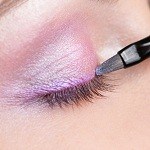Hepatitis C Lifestyle: Wearing Makeup


In many cultures, a majority of adult women (and some men) wear makeup on a daily basis. Despite the inclusion of cosmetics in so many people’s daily routine, few stop to think about how the liver reacts to cosmetics used on their face. People with chronic Hepatitis C are generally aware that what they eat or breathe can have a potential affect on their liver; however, it is easy to forget that what is absorbed through the skin (like makeup) should be included, too.
Some of us mistakenly believe that labels on cosmetics offer some kind of protection for the consumer. However, personal care ingredients in the U.S. don’t need Food and Drug Administration (FDA) approval, health studies or premarket testing. With drugs, the FDA takes steps to ensure their safety prior to being available on the market. With cosmetics, safety responsibility lies with the manufacturer. If a personal care product is determined to be unsafe, the manufacturer can be penalized – but that often happens after it has been on the market for a while.
Due to the stress Hepatitis C puts on the liver, people living with this virus can easily overload their liver with toxins. Infected liver cells are continually battling inflammation from Hepatitis C. Since the liver is primarily responsible for removing toxins from the body, any additional toxin load can push Hepatitis C-related inflammation into liver cell damage – a surefire way to advance liver disease. Toxins enter the bloodstream after they are ingested, but eating is not the only route for toxins to gain entry. The two other major routes for toxins are inhalation and absorption.
Frequently containing toxic ingredients, cosmetics are applied on the face, neck, lips and eyes – all high absorption areas of the skin. Using a product or two with a potentially toxic ingredient is not a big deal, if it is used occasionally. However, many people who wear makeup apply it every day – maybe even multiple times a day. Until more health conscious laws are applied to cosmetics, those with Hepatitis C should be on the lookout for the following four types of chemicals that are toxic to the liver:
- Phthalates including di-n-butyl phthalate (DBP) and di(2-ehtylhexyl) phthalate (DEHP)
- Lauryl sulfate (SLS) and sodium laureth sulfate (SLES)
- Diethanolamine (DEA), triethanolamine (TEA), amonoethanolamine (MEA)
- Propylene / butylene glycol (PG)
By keeping exposure to these chemicals to a minimum, the toxin load on the liver is reduced – an integral strategy for living healthfully with Hepatitis C.
For women or men who value cosmetics, there are manufacturers who hold themselves to a safety standard higher than the FDA. By either banning dangerous chemicals or reducing their reliance on them, the following companies are aware of the liver-related hazards associated with the ingredients just described. Although far from a comprehensive list, these manufacturers rank better in liver-friendly cosmetics than more conventional brands:
- Aubrey
- Burt’s Bees
- BWC – Beauty without Cruelty
- Dr. Hauschka
- Ecco Bella
- Giovanni
- Honeybee Gardens
- Lavera
- Weleda
Switching to a natural, organic, healthful brand of makeup is not a guarantee that your liver’s health will improve, but it does contribute to reducing the amount of chemicals your liver must process. In an ideal world, toxic ingredients in products that are applied to the skin would not be permitted for sale. Until then, preserving liver health is the consumer’s responsibility – a task that involves reading ingredient labels and choosing cosmetics that don’t contain known liver toxins.
References:
http://environment.about.com/od/healthenvironment/a/phthalates.htm, Phthalates in Cosmetics: Not Too Pretty”, Larry West, Retrieved April 13, 2013, About.com, 2013.
http://www.greenlivingonline.com/article/six-makeup-chemicals-avoid, Six Makeup Chemicals to Avoid, Shelagh McNally, Retrieved April 13, 2013.
http://www.healthguidance.org/entry/5119/1/Toxic-Ingredients-in-Cosmetics-and-Skin-Care-Products.html, Toxic Ingredients in Cosmetics and Skin Care Products, Nicky Pilkington, Retrieved April 13, 2013, Healthguidance.org, 2013.
http://www.makeupandbeautyblog.com/news/are-cosmetics-regulated-by-the-fda/, Are Cosmetics Regulated by the FDA?, Retrieved April 14, 2013, Makeup and Beauty Blog, 2013.
http://www.naturalhealthway.com/articles/chemicals/chemicals.html, The 10 Most Unwanted Ingredients in Personal Care & Beauty Products, Retrieved April 13, 2013, Natural Health Way, 2013.








4 Comments
I use Bubble & Bee soaps, shampoo and deodorants (www.bubbleandbee.com) and I use Lauren Brooke cosmetics and Real Purity mascara (www.naturaljoybeauty.com). Bubble & Bee doesn’t have ANY toxic ingredients, and the other two have the least offensive ingredients of any others I’ve found.
Pure Anada is a company that makes completely natural make up and no chemicals.
So what about safe hair dye
Is juicing a safe way to maintain good health with hep c?